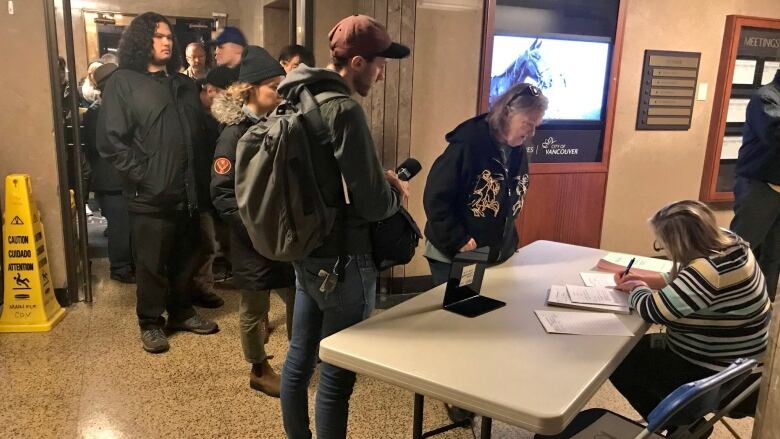Gregor Robertson's broken promise for DTES low-income housing infuriates residents
Operator of social housing building says it's not possible to make all units low-income as promised

Advocates for Downtown Eastside social housing say that Vancouver Mayor Gregor Roberson has reneged on a promise for 100 per cent welfare-rate accommodations at a proposed downtown development.
At a public hearing Tuesday, proponents called for the city to honour its commitment made to the DTES's most vulnerable residents by Robertson related toa 2016rezoning proposalto turn 58 West Hastings Street into a housing project.
But Karen Ward, with Our Homes Can't Wait, says the development proposal will make the building's rents too expensive for locals and breaks Robertson's promise when hesigned a pledgeto make the development "100 per cent welfare/pension rate community-controlled housing," or shelter-type housing.
Many here reminding @MayorGregor of his 2016 promise to develop #58WHastings at 100% shelter rates pic.twitter.com/FmKC5EUzxS
—@MaryseZeidlerKey distinction
The 58 West Hastings proposal calls for one-third or 231 of the building'sunits to be priced at shelter rates. The rest will qualify as social housing.
So what's the difference?
Welfare rate, pension rate or shelter rate refers toB.C. Housing's shelter maximumamount a person on income assistance would be required to pay for housing, which is currently at $375 per month for an employable single person.
Social housing in the DTES,according to Vancouver's housing strategy,is less restricted.
The strategy says for an entire building to be declared social housing, three conditions must be met:
- At least one third of the units must be rented out at or below the shelter maximum.
- It must be owned by a non-profit group, co-op or a government.
- It must be secured with a "housing agreement or other legal commitment."
Operator says 100% not possible
At Tuesday's meeting, Carol Lee with the Vancouver Chinatown Foundation, the non-profit behind the rezoning, saidhalf the building's units will be at the shelter rate.
The other half will be tied to theHousing Income Limit,which the provincial government uses to measure how much income a person needs to afford a particular rental home.
Luke Harrison with the Vancouver Affordable Housing Agency said operating the building at 100 per cent shelter rates would not be possible.
Luke Harrison with VAHA says 100% shelter rates means the building operations would be at a deficit from day 1 pic.twitter.com/mbZ2nCCTPr
—@MaryseZeidlerBut the 72 speakers at Tuesday's event did not backdown from their demands.
FloraMunroe, also with Our Homes Can't Wait, saidthe experience with the Woodward's development has shown mixing welfare andmainstream housingwon't work.
"A lot of people that are low-income, [have] the feeling they don't belong there because of the people paying higher rent," she said. "They don't feel comfortable. They're being stared at or talked about. They're just hiding themselves or they leave."
"How are you supposed to work yourself towardbeing socially acceptable if you're just being put down all the time?"
Erica Grant (sp?) is the first speaker of 72 speakers on the list tonight. In support of project if 100% shelter rates (applause). Says city must provide housing for First Nations if committed to reconciliation (she's Nisga'a) pic.twitter.com/myaYVp7Jd0
—@MaryseZeidlerA request for comment from the City of Vancouver has not been returned.
The meeting is scheduled to hear from additional speakers on Jan. 30.
With files from Maryse Zeidler












_(720p).jpg)


 OFFICIAL HD MUSIC VIDEO.jpg)
.jpg)



























































































